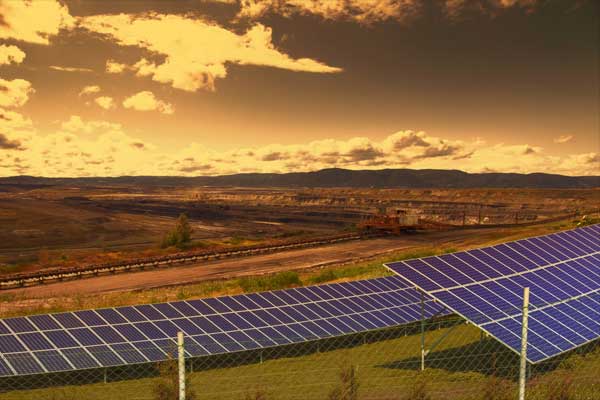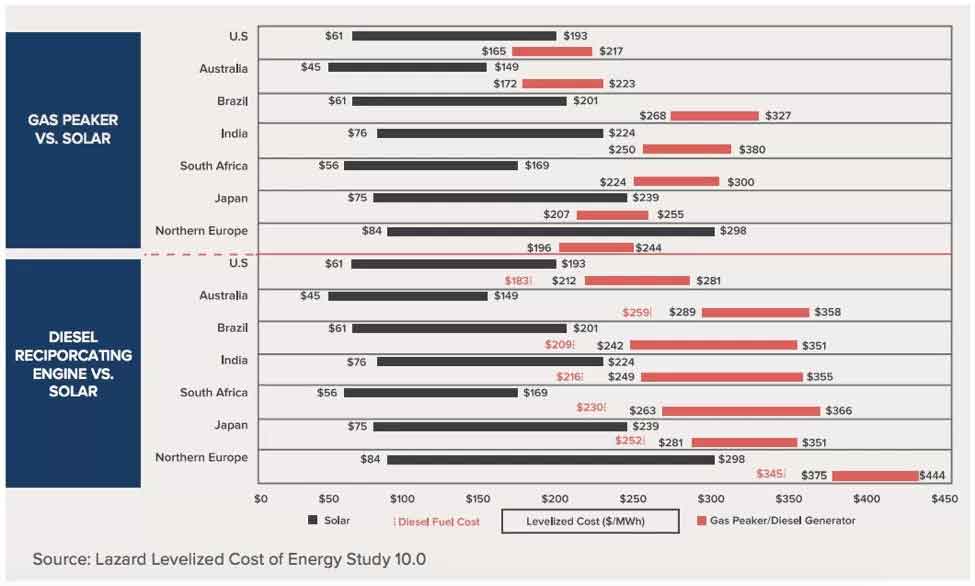Fossil fuels have been and continue to be a major source of energy in the mining sector, not only for powering the engines of the heavy equipment and machinery that make the mining processes possible but also for electricity generation[1].
When it comes to mining, a business as usual mode of continued intensive usage of fossil-fuels disregarding other sources of energy, means in a way opposing the global trends of carbon emission reductions, environmental and social due-diligence and sustainability and climate action; but not only that, it also means missing the economic benefits of renewable energy incorporation.
Given its substantial price reduction and environmental benefits, renewable energy solutions in-situ for providing energy in mining installations are becoming progressively more attractive, particular energy in the form of electricity.
A seeming paradox:
In many developed countries, several mines are connected to the grid, but it isn’t the case for developing countries. In both cases, however, the energy needs to be taken into account in order to determine the use of already existing infrastructure -without overloading it- or the need of building new plants.
The energy/electricity component is only one of the many facets that are inherently involved in mining. Despite the environmental regulations and more recently the use of clean, environmentally friendly renewable sources of energy for electricity generation, the assertion of ‘sustainable mining’ remains a metaphor.
The truth is that whilst renewable energy in the form of solar or wind, epitomizes sustainability; mining, to the eyes of the most radical environmentalists, constitutes the evilest way of environmental depredation and degradation no matter how social and environmentally responsible the mining operations might be. In a way, one poses to be the antithesis of the other.
But let’s face it, the fact is that renewable energy depends on mining for the raw materials that allow their products and systems to be manufactured. It is also undeniable that most mining jurisdictions possess plenty of opportunities for harnessing the existing abundant and free natural renewable energy resources.
Thus, beyond the tangible gains provided by carbon emission reductions, social acceptance and economic benefits that come along when embracing renewable energy in mining, ultimately, they depend on each other.
With that said, we cannot argue on that renewable energy and mining have become exceptional partners on the mission of forging sustainability, and hence creating a seeming paradox and a circular synergy.
In order to exemplify the vital role of mining on regards renewable energy, the following is a list of all the materials (minerals) needed for solar panels and lithium-ion batteries.
Solar PV Cells[2]
· Copper (wiring; thin film solar cells)
· Indium (solar cells)
· Lead (batteries)
· Phosphate rock (phosphorous)
· Silica (solar cells)
· Selenium (solar cells)
· Iron ore (steel)
· Molybdenum (photovoltaic cells)
· Cadmium (thin film solar cells)
· Tellurium (solar cells)
· Titanium dioxide (solar panels)
· Gallium (solar cells)
· Metallurgical coal (used to make steel)
· Silver
· Germanium
· Tin
· Arsenic (gallium-arsenide semiconductor chips)
· Bauxite (aluminum)
· Boron minerals (semiconductor chips)
Lithium-ion[3]
· Lithium
· Nickel
· Cobalt
· Aluminum
· Manganese
If there is a metal that can be proclaimed as the king of the renewable energy revolution, that would-be copper. Robert Friedland (Ivanhoe Mines) refers to copper in this way:
“Copper is the king of metals… Every single solution drives you to copper -solar power, wind power, electric cars, you name it.” -Robert Friedland, Ivanhoe Mines
In fact, copper constitutes an essential material in the clean energy transition, and not only because it is critical for most technological innovations, particularly in electronics, but moreover, because it is critical to the whole energy system. Copper indeed is used extensively to power transmission lines and to wiring in electric vehicles (note that electric vehicles require four times as much copper as internal combustion engines)[4]
McKinsey Global Institute estimates that primary copper demand could potentially grow by nearly 2% annually, reaching 31 million tonnes by 2035—a 43% increase in current demand of 22 million tonnes.
All the above doesn’t go without saying, in the future, recycling could become the new mining. Recognizing how many materials go into building solar panels, the solar industry has been making plans to re-use components as solar panels reach the end of their lives. This is not only to cut down on waste but also to recycle metals and minerals, unlocking a large stock of materials and other valuable components.
According to the Mining for Clean Energy 2017 report by Clean Energy Canada, it has been estimated that by 2030, the materials technically recoverable from recycled PV panels could produce approximately 60 million new panels. To put that in perspective, though, 180 million new panels were produced in 2015[5].
What is driving the viability of Renewable Energy in Mining?
According to the Rocky Mountain Institute[6], the key for unlocking viable energy systems low in carbon emissions for mining has been to great extent the dramatic reduction in the cost of renewable energy technologies and in a lesser extent, batteries and storage systems.
Since 2009, the global Levelized cost of energy (LCOE) for the wind (inland) has dropped 66 percent, and the LCOE for solar has dropped 85 percent.
Thus, Wind and Solar have become cost competitive compared to the energy generated from fossil fuels. From the economic perspective, mining operators can lock energy prices by an in-situ generation or by opting for long-term contracts (PPA’s) at competitive prices for 25 years.
The fact that renewable energy has the potential for preventing the price fluctuation of fossil fuels should be an important factor for deciding based on economics.
Whether it be a small scale thermal or solar PV solution or a rather larger solar or wind farm or run-of-river hydropower plant; the truth is that in the long run, it doesn’t take a huge EBC company to solve the energy supply and demand in mining, since renewables can be modularized and quickly shifted and utilized in conjunction with fossil-fuels in hybrid systems if needed.
To round-it-all-up, Energy Efficiency should always be added in the mix when finding the most optimum ways for optimizing gains and ultimately becoming sustainable whilst attaining economic benefits.
Examples as far as scale and energy sources and applicability in the mining industry abound and many cases of study and problems versus solutions can be found, however when it comes to practicality and with the potential for being replicated in many mining jurisdictions, as a way to tackle the electricity demand while reducing costs, is by building new in-situ off-grid installations with solar energy, which is becoming a preferred renewable energy solution for mining.
Although storage in the form of batteries might not be a part of the system, a mine that works on solar energy during the day and switches to fossil fuels during the night would still reduce its energy costs and its carbon footprint. In addition, renewable energy brings with it benefits in terms of reduction of exposure to the volatility of oil prices and the diesel supply chain.
Final insight:
By accomplishing the double purpose of satisfying both the needs of the mine and surrounding communities, renewable energy in mining sites has the potential of generating additional positive impacts in terms of social responsibility and community investment and ultimately being a driver for attaining social license.
Beyond the seeming paradox between mining and renewable energy, the fortunes of one are closely linked to the other in a synergistic circle. The next decade is poised to be one of robust and parallel growth for both. Achieving sustainable development in a way that economic prosperity can go hand in hand with environmental due-diligence and social gains will be not only a monumental challenge, but moreover key in the process of decarbonizing the economies of the future and contribute in the global efforts to mitigate climate change.
______________________________
[1] According to the Rocky Mountain Institute, typically approximately 32% of the energy consumption in a mine is in the form of electricity. Such electricity being either generated in place or supplied from the commercial grid. The remaining energy consumption is based on fossil fuels, mainly mobile heavy equipment with diesel engines (drilling rigs, trucks, excavators, etc.
[2] “Mining for Clean Energy. Tracking the Energy Revolution 2017”. Clean Energy Canada (cleanenergycanada.org) – The Metals and Minerals needed to make a solar PV panel (pg. 4)
[3] “Here are the raw materials we need to fuel the electric car boom”. October 26, 2017. Business Insider (businessinsider.com)
[4] “Mining for Clean Energy. Tracking the Energy Revolution 2017”. Clean Energy Canada (cleanenergycanada.org) – Facts on copper (pg. 5)
[5] “Mining for Clean Energy. Tracking the Energy Revolution 2017”. Clean Energy Canada (cleanenergycanada.org) – Recycling, the mining of the future (pg. 7)
[6] Digging for Carbon Cuts: How the Mining Industry Can Win with Renewables. July 26, 2017. Tegan Campia Paolo Natali, Ph.D. Published by Rocky Mountain Institute rmi.org















Comments